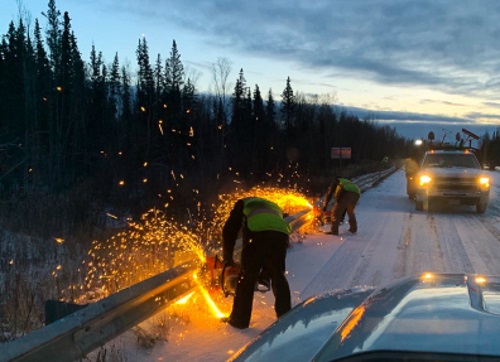Trying to make transportation systems safer and more reliable is going to entail deploying new strategies and new technologies, according to a panel discussion held at the American Association of State Highway and Transportation Officials 2019 spring meeting in Park City, UT.
Tony Kratofil (in photo above at podium), chief operating officer and chief engineer of the Michigan Department of Transportation, served as the panel’s moderator and stressed that “we’ve gone from building transportation systems to maintaining and operating them for the benefit of our citizens and, to my mind, safety and reliability go hand-in-hand to achieving that.”

Valerie Briggs (standing to the left in photo at right), director of the office of transportation management at the Federal Highway Administration, explained during her remarks that one avenue to achieving that is to develop “champions’ in operations; people who will really get into the nuts and bolts of transportation” and bring innovations to the industry.
“We’re heavily focused on the data component to this,” she said. “That is our first step: how to digitally define something like transportation that is so dynamic. But that is how we will help technology and transportation evolve.”
Brent Cain, assistant director of the Arizona DOT, provided insight into how his agency is tweaking its operations strategy to make some of those improvements.

“The expectation of the general public is the consistency of getting from point A to point B – and reliability is a key component for the system,” Cain (standing at right in photo at left) said. “And reliability needs in rural areas is definitely much different than the needs of urban areas. We need to grasp and understand that – it is not a one-size-fits-all measure.”
He added that the Arizona DOT is now co-locating state troopers at its transportation operations centers or TOCs at a cost of $1 million a year to help reduce traffic congestion caused by motor vehicle crashes and other issues. “They can quickly tell their fellow troopers where the scene of the crash is by tapping into our camera system – it’s very effective in helping clear crashes from the roadway faster, which is a huge benefit to us.”

Jeffrey Lindley (standing at right in photo at right), associate executive director and chief technical officer at the Institute of Transportation Engineers, stressed that reliability must be viewed holistically throughout the transportation system – not just component by component.
“The reliability of the transportation system as a whole, not just the highway, influences travel decisions,” he explained. “If one part of the trip is unreliable, then the whole trip is unreliable.”
Yet the focus on travel is also no longer on just certain transportation “corridors,” but more on user needs, how they make their trips, and the multimodal nature of those trips, Lindley said.
“Traveler information is important but changing as well,” he noted. “They want all options for trips, modes, and prices for those modes in front of them – from ride-hailing services to scooters and the subway. We need to provide people with multimodal information so users can plan their entire trip and know how much will cost – I think that is what 21st century travel must look like.”
One of the biggest struggles in making all of that happen is the constant effort required to get the word out about transportation performance. “It is extraordinarily difficult to communicate reliability to the general public,” Lindley explained.
“One thing we, as professionals, need to do is communicate to folks who are not in the middle of it every single day, particularly as we move towards autonomous vehicles,” he noted. “We need to explain to folks it is long journey to revolutionize transportation and make it safer for them as well.”



